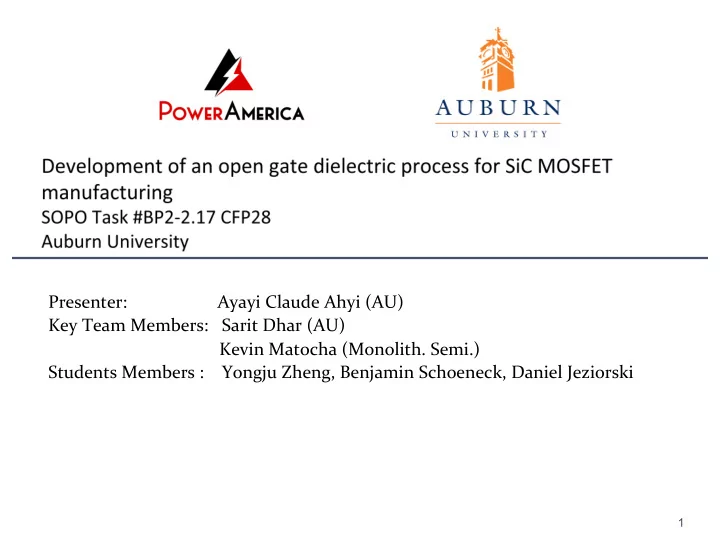

Presenter: ¡ ¡ ¡ ¡ ¡ ¡ ¡ ¡ ¡ ¡ ¡ ¡ ¡ ¡ ¡ ¡ ¡ ¡ ¡ ¡Ayayi ¡Claude ¡Ahyi ¡(AU) ¡ Key ¡Team ¡Members: ¡ ¡ ¡Sarit ¡Dhar ¡(AU) ¡ ¡ ¡ ¡ ¡ ¡ ¡ ¡ ¡Kevin ¡Matocha ¡(Monolith. ¡Semi.) ¡ ¡ Students ¡Members ¡: ¡ ¡ ¡ ¡Yongju ¡Zheng, ¡Benjamin ¡Schoeneck, ¡Daniel ¡Jeziorski ¡ ¡ ¡ ¡ ¡ ¡ ¡ 1
Mo#va#on ¡and ¡Objec#ve ¡ ¡ • Nitrogen passivation of the interface is the established technology. All methods of inserting nitrogen plateau around the same mobility values • In this project we are looking beyond Nitrogen using a series of short loop experiments. Lateral MOSFETs of 4 promising technologies are tested: • Ultra-High temperature oxidation • Ultra-High temperature oxidation with Sb counter doping for higher Field effect mobility • Boro-Silicate Glass (BSG) oxide devices • Ge strained SiC devices • The most performant in terms of mobility, stability, oxide strength and compatibility with current fabrication process will be selected for a test run of DMOSFETs 2
Ultra ¡High ¡Temperature ¡Oxida#on ¡ ¡ • ¡Easier ¡desorp#on ¡of ¡the ¡Carbon ¡ from ¡the ¡interface ¡ ¡ T. Kobayashi, J. Suda, T. Kimoto, "Reduction of Interface State Density in SiC(0001) MOS structures by Post-Oxidation Ar Annealing at High Temperature," ECSCRM Abstracts, 2016, pp. 203-204. 3
BSG ¡MOS ¡devices ¡ 4
Ge:SiC ¡ ¡ • Evidence of strain in the SiC lattice • Lower resisivity 5
What ¡has ¡been ¡accomplished ¡so ¡far ¡ Fabrica#on ¡of ¡the ¡of ¡the ¡common ¡template ¡for ¡the ¡devices ¡up ¡ to ¡Gate ¡oxide ¡or ¡ ¡Gate ¡implant ¡steps. ¡ Ultra ¡High ¡Temperature ¡Oxide ¡ ¡MOS ¡capacitors ¡and ¡MOSFETs ¡ Borosilicate ¡Glass ¡Devices ¡: ¡ ¡ Evalua#on ¡Borosilicate ¡glass ¡obtained ¡by ¡different ¡methods ¡using ¡ MOS ¡capacitors ¡ ¡ Characteriza#on ¡of ¡BSG ¡MOSFETs ¡from ¡B 2 O 3 ¡ solid ¡Source ¡ 6
Common ¡Template ¡for ¡all ¡devices ¡ RIE etch Implant Mask 1 Source/Drain implant Implant Mask 2
¡ Doping ¡profiles ¡ Carbon cap Activation@ 1600C SiO2 Mo SiC O 2 RIE P-well implant Sacrificial oxidation + BOE 8 8
BSG ¡processes ¡ Boron doping 1000 o C in Ar +O 2 Oxidation Drive in 1150 o C P-type SiC 1000 o C in Ar gate Process 1 BSG SiO 2 BSG n+ n+ n+ n+ n+ n+ n+ n+ n+ n+ P-type SiC P-type SiC P-type SiC P-type SiC Ar Ar O 2 O 2 Boron Nitride or oxide Anneal B implant 800 o C in Ar Process 2 gate SiO 2 BSG BSG n+ n+ n+ n+ n+ n+ n+ n+ n+ n+ P-type SiC P-type SiC P-type SiC P-type SiC P-type SiC Thin SiO 2 gate Process 3 PECVD BSG BSG n+ n+ n+ n+ n+ n+ n+ n+ P-type SiC P-type SiC P-type SiC P-type SiC 9
BSG ¡gate ¡oxide ¡devices ¡ ¡ BSG gate oxide devices : comparison of B doping methods BN solid source doped devices showed too weak oxides to be fully characterized. They have been dropped from the study. The high interface trap density of the implanted Boron devices also shows more in depth work would need to be done on these device. Therefore they were also dropped from this study. 10
BSG: ¡Oxide ¡strength ¡and ¡stability ¡ BSG gate oxide devices : stability and reliability Preliminary results have been obtained in oxide breakdown strength and reliability 11
BSG ¡MOSFET ¡(B 2 O 3 ¡source) ¡ • Devices show high field effect mobility • Reduced interface trap density • Residual instability is possibly due to impurity in the doping material • Deposited BSG shows great promise in reducing unwanted impurities 12
Ultrahigh ¡temperature ¡Oxida#on ¡ Process ¡1 ¡ Oxide ¡growth ¡at ¡1425 o C ¡ Ramp ¡up ¡and ¡ramp ¡down ¡under ¡Ar ¡ flow ¡ Process ¡2 ¡ Oxide ¡growth ¡at ¡1150 o C ¡ Anneal ¡in ¡Ar ¡at ¡1500 o C ¡ 13
1425 o C ¡oxida#on ¡ • 10 min in O 2 at 1425 o C • Ramp up and down in Ar • Thicker than expected oxide, suggests oxidation during rampu up and ramp down • High trap density; The interface seems unpassivated • Low Mobility • Significant Gate leakage • High contact resistance due to Al contact 14
1500 o C ¡Ar ¡Anneal ¡ • Interface trap density similar to unpassivated oxides • Original process requires extremely fast cooling that could not be replicated. Ramp down was limited to 5 o /min to avoid cracking the furnace tube • AFM Image of the oxide shows dendrite-like defects, possibly due to crystallization 15
Conclusion ¡ • So far Ultra high temperature oxidation did not show any advantage in trap density reduction, oxide strength or carrier mobility. • A fair evaluation of ultra high temperature oxidation requires process equipment with higher performance to reduce parasitic growth, contamination andcooling rate. • Devices with Ni ohmic contacts will be made. 16
Remaining ¡Work ¡ • Sb counter doped Ultra High temperature oxide devices. • Revisit Ultra High temperature oxide devices with improved set up • Ge strained SiC devices 17
Recommend
More recommend